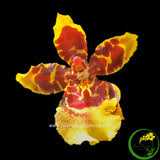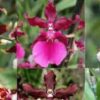# How to Handle Yellow Leaves on Oncidium Orchids

Oncidium orchids, often known as “Dancing Lady Orchids,” are beloved for their stunning floral displays and diverse species. However, like all plants, they can face challenges, including the unsightly issue of yellowing leaves. Yellow leaves can indicate various problems, from overwatering to nutrient deficiencies. Understanding the causes and solutions for this issue is crucial for maintaining healthy Oncidium orchids. This comprehensive guide will delve into the reasons behind yellow leaves and provide effective treatment and prevention strategies.
## 1. Understanding the Causes of Yellow Leaves
Before addressing yellow leaves, it’s important to identify the underlying causes. Here are some common reasons why Oncidium orchids develop yellow leaves:
### 1.1 Overwatering
**Symptoms:**
– Yellowing leaves starting from the bottom.
– Soft, mushy roots.
Overwatering is one of the most common issues for orchid growers. Oncidiums prefer to dry out between waterings. Excess water can lead to root rot, depriving the plant of essential nutrients and oxygen.
### 1.2 Underwatering
**Symptoms:**
– Wilting leaves.
– Dry, crispy edges on leaves.
Conversely, underwatering can also cause yellow leaves. While Oncidiums can tolerate some dryness, prolonged periods without water can lead to stress and yellowing.
### 1.3 Nutrient Deficiencies
**Symptoms:**
– Yellowing leaves, often starting with older leaves.
– Stunted growth.
Nutrient deficiencies, particularly nitrogen, can lead to chlorosis (yellowing) in leaves. This often manifests as yellowing starting from the tips or edges and progressing inward.
### 1.4 Pest Infestations
**Symptoms:**
– Yellowing leaves with visible pests or webbing.
– Sticky residue on leaves.
Pests like spider mites, aphids, and mealybugs can sap the vitality from your Oncidium, leading to yellow leaves. These pests can cause direct damage and stress the plant, resulting in yellowing.
### 1.5 Fungal or Bacterial Infections
**Symptoms:**
– Dark spots or patches on yellow leaves.
– Soft, mushy areas on leaves.
Fungal or bacterial infections can lead to yellowing and other signs of distress, such as spots or lesions on the leaves.
### 1.6 Environmental Stress
**Symptoms:**
– Yellow leaves appearing suddenly.
– Leaf drop in extreme cases.
Sudden changes in environmental conditions—such as temperature fluctuations, inadequate humidity, or excessive direct sunlight—can cause stress and result in yellow leaves.
## 2. Diagnosing the Problem
To effectively treat yellow leaves on Oncidium orchids, it’s essential to diagnose the specific issue accurately. Here are some steps to help determine the cause:
### 2.1 Inspect the Roots
1. **Remove the Orchid from Its Pot**: Carefully take the orchid out of its pot to examine the roots.
2. **Assess the Condition**: Healthy roots should be firm and greenish-white. If they appear brown, mushy, or shriveled, overwatering may be the issue.
3. **Clean and Trim**: If you find rotten roots, trim them back with sterilized scissors and repot the orchid in fresh, well-draining potting mix.
### 2.2 Check the Watering Schedule
1. **Evaluate Moisture Levels**: Stick your finger into the potting mix to check for moisture. If the mix feels consistently wet, reduce the frequency of watering. If it feels dry, increase watering.
2. **Observe the Plant’s Response**: Adjust your watering schedule based on your observations over the next few weeks.
### 2.3 Inspect for Pests
1. **Examine Leaves and Stems**: Look closely at the leaves and stems for any signs of pests or webs.
2. **Conduct a Sticky Trap Test**: Place yellow sticky traps near the orchid to catch flying pests, helping you identify any potential infestations.
### 2.4 Analyze Nutrient Levels
1. **Consider Fertilization Practices**: If you haven’t fertilized recently, or if you suspect a nutrient deficiency, consider using a balanced orchid fertilizer.
2. **Observe Leaf Color**: If yellowing persists despite appropriate watering, it may indicate a nutrient deficiency.
### 2.5 Review Environmental Conditions
1. **Check Humidity and Temperature**: Ensure that your orchid is in an environment with adequate humidity (ideally 40-70%) and a consistent temperature range (65-80°F or 18-27°C).
2. **Adjust Light Levels**: Ensure your orchid is receiving the right amount of indirect sunlight; too much direct sunlight can scorch leaves and lead to yellowing.
## 3. Treatment Strategies for Yellow Leaves
Once you’ve identified the cause of yellow leaves in your Oncidium orchids, you can take appropriate measures to address the issue. Here are targeted treatment strategies based on specific problems:
### 3.1 Overwatering Treatment
– **Repotting**: If root rot is severe, repot your orchid into a fresh potting mix, ensuring that the new mix has good drainage.
– **Adjust Watering Schedule**: Allow the potting medium to dry out between waterings, typically every 7-14 days, depending on the humidity and temperature.
### 3.2 Underwatering Treatment
– **Increase Watering Frequency**: Water your orchid more frequently, ensuring the potting medium is consistently moist but not soggy.
– **Soak Method**: If the orchid is severely underwatered, soak the pot in water for 10-15 minutes to rehydrate it thoroughly.
### 3.3 Nutrient Deficiency Treatment
– **Fertilization**: Apply a balanced, water-soluble orchid fertilizer every 4-6 weeks during the growing season. Look for a formula with equal parts nitrogen, phosphorus, and potassium.
– **Foliar Feeding**: Consider foliar feeding with a diluted fertilizer solution to provide immediate nutrients through the leaves.
### 3.4 Pest Management
– **Insecticidal Soap or Neem Oil**: Treat infested orchids with insecticidal soap or neem oil, following the product instructions. Ensure thorough coverage of the affected areas.
– **Regular Monitoring**: Keep an eye on your orchid after treatment to ensure pests do not return.
### 3.5 Addressing Fungal or Bacterial Infections
– **Remove Infected Leaves**: Prune any yellowing leaves showing signs of infection, using sterilized scissors to prevent further spread.
– **Fungicide Treatment**: Apply a suitable fungicide to the affected area, following the instructions carefully. Ensure good air circulation around the plant.
### 3.6 Managing Environmental Stress
– **Temperature and Humidity Control**: Use a humidifier to maintain optimal humidity levels, and avoid placing the orchid in drafts or areas with extreme temperature fluctuations.
– **Light Adjustment**: If the orchid is receiving too much direct sunlight, consider moving it to a shadier location or using sheer curtains to filter the light.
## 4. Prevention Strategies for Healthy Oncidium Orchids
To minimize the risk of yellow leaves in the future, implement these preventive measures:
### 4.1 Proper Watering Practices
– **Watering Routine**: Develop a consistent watering routine based on environmental conditions. Use a moisture meter if needed.
– **Drainage**: Ensure pots have adequate drainage holes to prevent water accumulation.
### 4.2 Nutritional Care
– **Balanced Fertilization**: Apply a balanced orchid fertilizer during the growing season to ensure your Oncidium receives essential nutrients.
– **Seasonal Adjustments**: Reduce fertilization frequency during the dormancy period.
### 4.3 Pest Prevention
– **Regular Inspections**: Regularly check for pests and take action at the first signs of infestation.
– **Cultural Controls**: Maintain good hygiene in the growing area by removing dead leaves and debris.
### 4.4 Environmental Stability
– **Consistent Conditions**: Place orchids in stable environments, avoiding areas with significant temperature fluctuations or drafts.
– **Humidity Management**: Use humidity trays or misters to maintain appropriate humidity levels.
## 5. Conclusion
Yellow leaves on Oncidium orchids can indicate various underlying issues, ranging from overwatering to nutrient deficiencies. By understanding the causes, diagnosing the problem accurately, and implementing targeted treatment strategies, orchid enthusiasts can restore their plants to health. Additionally, practicing preventive care will help ensure your Oncidium orchids thrive, avoiding future yellowing issues. With proper attention and care, these beautiful orchids can flourish and provide stunning blooms for years to come. Whether you are a seasoned orchid grower or a newcomer, keeping an eye on your Oncidium’s leaves will help you maintain a vibrant and healthy plant.

